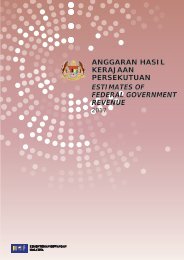WEALTH
2c0esX1
2c0esX1
You also want an ePaper? Increase the reach of your titles
YUMPU automatically turns print PDFs into web optimized ePapers that Google loves.
FOCUS<br />
of InterMedika, his international healthcare consultancy in<br />
downtown Bangkok.<br />
With the Internet becoming ever more prevalent and<br />
insurance premiums and co-payments increasing,<br />
Schroeder expects that patients will want more control<br />
over healthcare providers. “We may soon see something<br />
like TripAdvisor for healthcare,” he reflects. “Patients are<br />
picking up more of the bill, so inexpensive, quality, foreign<br />
alternatives are likely to become more important to them.”<br />
PLASTIC SURGERY WITH A HOLIDAY<br />
Bumrungrad is the poster child of medical tourism. It looks<br />
like a five-star hotel and has services to match. There are 21<br />
VIP suites, a Japanese restaurant, a McDonald’s, and a<br />
queue of people buying snacks from Starbucks. The hospital<br />
facilities include 19 operating rooms equipped for general<br />
surgery and surgical specialties, and 1,200 surgeons and<br />
dentists, of whom more than 200 are US board certified.<br />
Cost and quality are the key selling points for<br />
Bumrungrad, and for rivals such as Samitivej, Phyathai<br />
International and Bangkok Hospital. At Bumrungrad, a<br />
package for coronary artery bypass graft surgery costs<br />
$19,000. In the United States, an uninsured patient will be<br />
set back $80,000 at least for the same.<br />
Yet the success of Bumrungrad was accidental.<br />
Schroeder and his team re-opened the 12-storey hospital in<br />
late 1996, with 580 beds and a $60 million debt on their<br />
books. Then the 1997 Asian financial crisis hit. The Thai<br />
baht plummeted, “doubling our debt and halving our<br />
potential market overnight,” recalls Schroeder.<br />
During the crisis, squeezed middle-class Thais<br />
switched to the cheaper state-funded healthcare system.<br />
Underused private facilities, like Bumrungrad, went into<br />
survival mode and offered surplus capacity to foreigners<br />
from the region seeking medical and surgical treatments<br />
as a cost-effective alternative to providers at home.<br />
Consequently, Schroeder bristles slightly at the notion<br />
of “medical tourism,” noting the term can be misleading.<br />
“People who come for serious medical care don’t ask how<br />
close we are to the beaches. They come for quality<br />
procedures conducted at a fair price in an environment<br />
with good infrastructure.”<br />
CREATIVE ACCOUNTING<br />
The Thai industry really boomed after 9/11. Tightening visa<br />
conditions in Europe and the United States meant people<br />
from Arab countries preferred to take the seven-hour flight<br />
east to Bangkok. Today, Bumrungrad has an Islamic prayer<br />
room, a certified halal kitchen and more than 150<br />
interpreters, many of them Arabic for the benefit of Gulf<br />
Muslim patients, now one of its most important markets.<br />
Altogether, Bumrungrad serves 1.1 million patients a year,<br />
including 520,000 who visit from other nations. In 2013, it<br />
generated $477 million in revenue. However, reliable data<br />
on global medical tourism is difficult to come by and the<br />
numbers are often overblown.<br />
In 2008, Deloitte projected that annual patient outflows<br />
from the US would be 10 million by 2012 and worth $21<br />
billion a year to developing countries. It was a brave<br />
prediction, considering most Americans do not even own<br />
valid passports. The figures were revised down one year<br />
later. Only 1.6 million Americans would be seeking<br />
healthcare outside the US in 2012.<br />
“Such projections invariably overestimate demand,”<br />
says Johanna Hanefeld, senior lecturer in health policy and<br />
systems at the London School of Hygiene and Tropical<br />
Medicine. In 2010, only 167,000 medical tourists attended<br />
Thai hospitals, according to research she conducted with<br />
Thinakorn Noree and Richard Smith – far less than Deloitte<br />
and the Thai government expected. The Thai Ministry of<br />
Commerce estimated, for example, that in 2006, 1.2 million<br />
medical tourists accessed health services in Thailand.<br />
Malaysia is often touted as another medical tourism<br />
success story. The country welcomed more than 850,000<br />
global medical tourists and took in $230 million of revenue<br />
last year, according to the Malaysian Ministry of Health.<br />
Hanefeld has good reason to treat such predictions with a<br />
skeptical eye.<br />
The issue is how numbers are counted. For example,<br />
almost 30 million tourists visited Thailand in 2015. The<br />
group coming primarily for medical treatment was only a<br />
fraction. But Thailand counts every interaction with the<br />
healthcare system, from the consultation to the x-ray or CT<br />
scan, as well as the operation, as separate interactions. By<br />
this count, one person can have up to 20 treatments per<br />
visit. Such “creative accountancy” greatly inflates medical<br />
tourist numbers.<br />
Hanefeld believes that “medical tourism remains on a<br />
much smaller scale in Thailand than is promoted, so its<br />
effect on the domestic health system is limited.” She also<br />
believes it is unlikely that a global medical tourism market<br />
in Thailand, or indeed elsewhere, will develop soon along<br />
the line the boosters claim. “Most people want to be treated<br />
locally or at least in their home region when they’re sick,”<br />
she explains. There are also serious issues such as differing<br />
national judicial systems that mean there is little chance<br />
for compensation should malpractice suits arise, unless<br />
patients are prepared for a legal battle in the host country.<br />
Continuity of care can also be missing when the patient<br />
finally returns home.<br />
Based on the success of Bumrungrad and its rivals,<br />
Schroeder believes the value proposition for medical<br />
24 • Allianz



